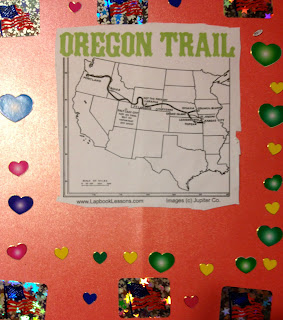Even before I started homeschooling, and especially after I started, I had a dream. The dream was a house... with an eat-in kitchen... and a playroom/ schoolroom off that eat-in kitchen... all separated from the 'formal' living area....
And the walls would be lined with IKEA Trofast shelving... and book displays... and a door would lead from this wondrous room into the back yard, per Maria Montessori's recommendation....
I didn't feel sorry for myself (most days), just a little frustrated, by the materials stuck here and there, but never where I needed them, when I wanted them. Aggravated by the sticky door on my jumbled supply closet. Piqued by our meticulously de-cluttered toy collection that never got picked up, despite its manageable size and scope. And I dreamed of that room... wood floors, hopefully... a fireplace even?
Well, ladies and gentlemoms, here it is:
this year I got that room.
Oh, I paid for it I think, with a stressful move during a wicked-hot drought, a messy third trimester with a messier house... and the room doesn't have any windows except that door into the backyard (forgot to add windows into the dream...).
And add to that, my husband had to go to Minneapolis on business a few weeks ago, and guess what? Trofast shelves hitchhiked home in his trunk. And guess what else? Ruined carpet meant ripping out the carpet and laying wood down (well, actually faux wood plank tiles, but good enough for me).
So go on, ask me- is it heaven? Has our homeschool achieved new heights; has the play in this hallowed space been more soulful, more perfect? Has my dream layout brought true happiness?
O friends, you know the answer by now, don't you? You do.
It's just a room. Right now, those wood planks are covered with toys and the art table looks like Picasso's studio recently vomited all over, spilling down onto the floor. And several projects are still in progress on my dining table. The more school-ish math and phonics books still sit in a stack on my bookcase in the living room because hey, I like to nurse where it's quiet and little people apparently like to do math where it's quiet, too.
Last week, I'll admit, I felt a little let down. All my great ideas weren't magic. Things work just like they always have, and frankly, it robs the sweetness of achieving my dream set-up. My books are organized, well, a little bit- but I still have to use them.
What I used to have- rubbermaid totes for sorting the toys, stacks of books here and there, art supplies stuffed in the dining room cabinet- worked for us just fine. And what I've designed and done in our new home works, too. But it's US who work, really, isn't it- myself and my little people! Not the storage furniture. And by the way, IKEA Trofast shelves do look nice, but someone still has to put the toys away in them....
Do you ever do this? Dream of how you wish you had more space, better shelves, enough baskets for all the toys, an organized supply closet, and so on and so forth? Are you waiting to carve out that art nook/ reading nook/ nature table till you move to a bigger house/ declutter/ organize your supplies/ have a weekend to yourself?
I wouldn't. Because it's pretty rare and pretty miraculous for some dreams to come true. I know I never really expected to have my daydream come true. That's why I always forced myself to make an art nook when there wasn't really room for one. And now I realize that the real secret is:
Work with what you have, because what you have, works.
Waiting for the fish to bite or waiting for wind to fly a kite. Or waiting around for Friday night or waiting perhaps for their Uncle Jake or a pot to boil or a better break or a string of pearls or a pair of pants or a wig with curls or another chance. Everyone is just waiting. ~Dr. Seuss
Enjoy yourself. It's later than you think. ~Chinese Proverb
As you grow older, you'll find the only things you regret are the things you didn't do. ~Zachary Scott
For a long time it had seemed to me that life was about to begin - real life. But there was always some obstacle in the way. Something to be got through first, some unfinished business, time still to be served, a debt to be paid. Then life would begin. At last it dawned on me that these obstacles were my life. ~Fr. Alfred D'Souza
























